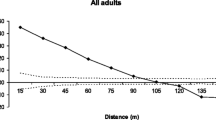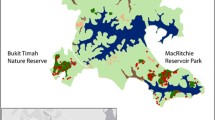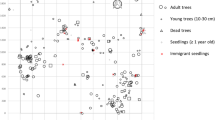Abstract
Genetic diversity of tree populations is mainly determined by pollen and seed flow. In turn, dispersal agents are affected by landscape composition and configuration. Understanding the effects of anthropization on pollen and seed dispersal in natural environments is crucial to developing long-term strategies for in situ and ex situ conservation of Neotropical savanna tree species. Here, we evaluated the genotypic and genetic diversity, spatial genetic structure (SGS), and pollen and seed dispersal of the endangered tree species Hymenaea stigonocarpa in a 2200-ha plot established in a strongly fragmented savanna landscape in Brazil. A total of 157 individuals were identified, 66 juveniles and 91 adults. Height, root-collar diameter for juveniles and diameter at breast height for adults were determined for each individual, and leaves were sampled to be used in genotyping by microsatellites. Genotypic diversity (\(R\)) was similarly high in adults (0.87) and juveniles (0.80), indicating more sexual reproduction than clonal. Heterozygosities were also similar between both generations, and no inbreeding was detected. Adults and juveniles present SGS, but the extent measured by the \(Sp\)-statistic was not significant. Both pollen and seed flow were elevated (24.2%) and reached long distances (3778 m and 3914 m, respectively) within the sampled area, but the pattern was not fat-tailed, indicating that most dispersal was over shorter distances. We conclude that fragmentation does not reproductively isolate the sampled population because individuals located outside the area may serve as sources of gene flow between remnant forest patches; however, the probability of dispersal over long distances is reduced.



Similar content being viewed by others
References
Aguilar R, Quesada M, Ashworth L, Herrerias-Diego Y, Loco J (2008) Genetic consequences of habitat fragmentation in plant populations: susceptible signals in plant traits and methodological approaches. Mol Ecol 17:5177–5188
Allendorf FW, Gordon L (2007) Conservation and the genetics of populations. Blackwell Publishing, Oxford
Arroyo-Rodriguez V, Pineda E, Escobar F, Benitez-Malvido J (2009) Value of small patches in the conservation of plant-species diversity in highly fragmented rainforest. Conserv Biol 23:729–739
Austerlitz F, Dick CW, Dutech C, Klein EK, Oddou-Muratorio S, Smouse PE et al (2004) Using genetic markers to estimate the pollen dispersal curve. Mol Ecol 13:937–954
Bittencourt JVM, Sebbenn AM (2009) Genetic effects of forest fragmentation in high-density Araucaria angustifolia populations in Southern Brazil. Tree Genet Genome 5:573–582
Bressan EA, Rossi ML, Gerald LT, Figueira A (2014) Extraction of high-quality DNA from ethanol-preserved tropical plant tissues. BMC Res Notes 7:268
Carneiro FS, Lacerda AEB, Lemes M, Gribel R, Kanashiro M, Wadt LHO, Sebbenn AM (2011) Effects of selective logging on the mating system and pollen dispersal of Hymenaea courbaril L. (Leguminosae) in the Eastern Brazilian Amazon as revealed by microsatellite analysis. For Ecol Manag 262:1758–1765
Chybicki IJ, Burczyk J (2009) Simultaneous estimation of null alleles and inbreeding coefficients. J Hered 100:106–113
Chybicki IJ, Burczyk J (2010) NM+: software implementing parentage-based models for estimating gene dispersal and mating patterns in plants. Mol Ecol Resour 10:1071–1075
Ciampi AY, Azevedo VCR, Gaiotto FA, Ramos AC, Lovato MB (2008) Isolation and characterization of microsatellite loci for Hymenaea courbaril and transferability to Hymenaea stigonocarpa, two tropical timber species. Mol Ecol Resour 8:1074–1077
Collevatti RG, Lima JS, Soares TN, Telles MPDC (2010) Spatial genetic structure and life history traits in Cerrado tree species: inferences for conservation. Nat Conserv 8:54–59
Creste S, Tulmann Neto A, Figueira A (2001) Detection of single sequence repeat polymorphisms in denaturing polyacrylamide sequencing gels by silver staining. Plant Mol Biol Rep 19:299–306
Defavari GR, Tarazi R, Moreno MA, Ferraz EM, Gandara FB, Kageyama PY (2009) Estrutura genética especial intrapopulacional de Hymenaea stigonocarpa Mart. Ex Hayne na Estação Ecológica de Itirapina, SP. Sci For 37:89–98
Degen B, Sebbenn AM (2014) Genetic and tropical forest. In: Pancel L, Kölh M (eds) Tropical forestry handbook, 2nd edn. Springer, Berlin, pp 1–30
Dering M, Chybicki IJ, Raczka G (2015) Clonality as a driver of spatial genetic structure in populations of clonal tree species. J Plant Res 128:731–745
Dick CW (2001) Genetic rescue of remnant tropical trees by an alien pollinator. Proc Roy Soc B Biol Sci 268:2391–2396
Dorken ME, Eckert CG (2001) Severely reduced sexual reproduction in northern populations of a clonal plant, Decodon verticillatus (Lythraceae). Ecology 89:339–350
Dow BD, Ashley MV (1998) High levels of gene flow in bur oak revealed by paternity analysis using microsatellites. J Hered 89:62–70
Durigan G, Siqueira MF, Franco GADC (2007) Threats to the Cerrado remnants of the state of São Paulo, Brazil. Sci Agric 64:355–363
Ellstrand NC (1992) Gene flow among seed plant populations. New For 6:241–256
Finger A, Kettle CJ, Kaiser-Bunbury CN, Valentin T, Mougal J, Ghazoul J (2012) Forest fragmentation genetics in a formerly widespread island endemic tree: Vateriopsis seychellarum (Dipterocarpaceae). Mol Ecol 21:2369–2382
Fischer J, Lindenmayer DB (2007) Landscape modification and habitat fragmentation: a synthesis. Glob Ecol Biogeogr 16:265–280
Foley JA, Defries R, Asner GP et al (2005) Global consequences of land use. Science 309:570–574
Fragoso JMV (1997) Tapir-generated seed shadows: scale-dependent patchiness in the Amazon rain forest. J Ecol 85:519–529
Frankel OH, Soule MS (1981) Conservation and evolution. Cambridge University Press, Cambridge
Franklin IA (1980) Evolutionary change in small populations. In: Soulé ME, Wilcox BA (eds) Conservation biology: an evolutionary-ecological perspective. Sinauer Associates, Sunderland, pp 135–150
Garcia AS, Ballester MVR (2016) Land cover and land use changes in a Brazilian Cerrado landscape: drivers, processes, and patterns. J Land Use Sci 11:1–22
Garcia AS, Sawakuchi HO, Ferreira ME, Ballester MVR (2017) Landscape changes in a neotropical forest-savanna ecotone zone in central Brazil: the role of protected areas in the maintenance of native vegetation. J Environ Manag 187:16–23
Gelmi-Candusso TA, Heymann EW, Heer K (2017) Effects of zoochory on the spatial genetic structure of plant populations. Mol Ecol 26:5896–5910
Gibbs PE, Oliveira PE, Bianchi MB (1999) Postzygotic control of selfing in Hymenaea stigonocarpa (Leguminosae-Caesalpinioideae), a bat-pollinated tree of the Brazilian cerrados. Int J Plant Sci 160:72–78
Godefroid S, Janssens S, Vanderborght T (2014) Do plant reproductive traits influence species susceptibility to decline? Plant Ecol Evol 147:154–164
Goudet J (1995) FSTAT (Version 1.2): a computer program to calculate F-statistics. J Hered 86:485–486
Hamrick JL (2004) Response of forest trees to global environmental changes. For Ecol Manag 197:323–335
Hardy OJ, Vekemans X (2002) SPAGEDi: a versatile computer program to analyse spatial genetic structure at the individual or population levels. Mol Ecol Notes 2:618–620
Hardy OJ, Maggia L, Bandou E et al (2006) Fine-scale genetic structure and gene dispersal inferences in 10 Neotropical tree species. Mol Ecol 15:559–571
Hoffmann WA, Haridasan M (2008) The invasive grass, Melinis minutiflora, inhibits tree regeneration in a Neotropical Savanna. Aust Ecol 33:29–36
Holderegger R, Buehler D, Gugerli F, Manel S (2010) Landscape genetics of plants. Trends Plant Sci 15:675–683
Ismail SA, Ghazoul J, Ravikanth G et al (2012) Does long-distance pollen dispersal preclude inbreeding in tropical trees? Fragmentation genetics of Dysoxylum malabaricum in an agroforest landscape. Mol Ecol 21:5484–5496
Ismail SA, Ghazoul J, Ravikanth G et al (2014) Fragmentation genetics of Vateria indica: implications for management of forest genetic resources of an endemic dipterocarp. Conserv Genet 15:533–545
Jump AS, Peñuelas J (2006) Genetic effects of chronic habitat fragmentation in a wind-pollinated tree. Proc Natl Acad Sci USA 103:8096–8100
Kalinowski ST, Taper ML, Marshall TC (2007) Revising how the computer program CERVUS accommodates genotyping error increases success in paternity assignment. Mol Ecol 16:1099–1106
Kramer AT, Ison JL, Ashley MV, Howe HF (2008) The paradox of forest fragmentation genetics. Conserv Biol 22:878–885
Lander TA, Boshier DH, Harris SA (2010) Fragmented but not isolated: contribution of single trees, small patches and long distance pollen flow to genetic connectivity for Gomortega keule, and endangered tree. Biol Conserv 143:2383–2590
Lemke TO (1984) Foraging ecology of the long-nosed bat, Glossophaga soricina, with respect to resource availability. Ecology 65:538–548
Lennartsson T (2002) Extinction thresholds and disrupted plant–pollinator interactions in fragmented plant populations. Ecology 83:3060–3072
Loiselle BA, Sork VL, Nason J, Graham C (1995) Spatial genetic-structure of a tropical understory shrub, Psychotria officinalis (Rubiaceae). Am J Bot 82:1420–1425
Lowe AJ, Boshier D, Ward M et al (2005) Genetic resource impacts of habitat loss and degradation; reconciling empirical evidence and predicted theory for neotropical trees. Heredity 95:255–273
Marshall TC, Slate J, Kruuk LEB, Pemberton J (1998) Statistical confidence for likelihood-based paternity inference in natural populations. Mol Ecol 7:639–655
Martins K, Chaves LJ, Vencovsky R, Kageyama PY (2011) Genetic structure based on nuclear and chloroplast microsatellite loci of Solanum lycocarpum A. St. Hil. (Solanaceae) in Central Brazil. Genet Mol Res 10:665–677
Miller MP, Bianchi CA, Mullins TD, Haig SM (2013) Associations between forest fragmentation patterns and genetic structure in Pfrimer’s Parakeet (Pyrrhura pfrimeri), an endangered endemic to central Brazil’s dry forests. Conserv Genet 14:333–343
Moraes MLT, Sebbenn AM (2011) Pollen dispersal between isolated trees in the Brazilian Savannah: a case study of the Neotropical tree Hymenaea stigonocarpa. Biotropica 43:192–199
Moraes MLT, Kageyama PY, Sebbenn AM (2007) Mating system in small fragmented populations and isolated trees of Hymenaea stigonocarpa. Sci For 74:75–86
Moraes MA, Kubota TYK, Rossini BC et al (2018) Long-distance pollen and seed dispersal and inbreeding depression in Hymenaea stigonocarpa (Fabaceae: Caesalpinioideae) in the Brazilian savannah. Ecol Evol 9:1–17
Moreno MA, Tarazi R, Ferraz EM et al (2009) Spatial genetic structure of Hymenaea stigonocarpa Mart. ex Hayne assessed with chloroplast microsatellite markers. Sci For 37:513–523
Omondi SF, Odee DW, Ongamo GO et al (2018) Mating patterns of the gum arabic tree (Acacia senegal synonym Senegalia senegal) in two different habitats. New For 49:53–65
Oyama K, Herrera-Arroyo ML, Rocha-Ramírez V, Benítez-Malvido J, Ruiz-Sánchez E, González-Rodríguez A (2017) Gene flow interruption in a recently human-modified landscape: the value of isolated trees for the maintenance of genetic diversity in a Mexican endemic red oak. For Ecol Manag 390:27–35
Ramos KMO, Felfili JM, Silva JCS, Fagg CW, Franco AC (2003) Desenvolvimento inicial de plântulas de Hymenaea stigonocarpa Mart. ex. Hayne, sob diferentes condições de sombreamento. Brasil Flor 22:37–42
Ramos ACS, Lemos-Filho JP, Ribeiro RA, Santos FR, Lovato MB (2007) Phylogeography of the tree Hymenaea stigonocarpa (Fabaceae: Caesalpinioideae) and the influence of quaternary climate changes in the Brazilian Cerrado. Ann Bot 100:1219–1228
Ratter JA, Bridgewater S, Ribeiro JF (2006) Biodiversity patterns of the woody vegetation of the Brazilian Cerrado. Neotropical savannas and seasonally dry forests: plant diversity, biogeography, and conservation. CRC Press, Boca Raton
Sampson JF, Byrne M, Gibson N, Yates C (2016) Limiting inbreeding in disjunct and isolated populations of a woody shrub. Ecol Evol 6:5867–5880
Sebbenn AM, Carvalho ACM, Freitas MLM, Moraes SMB, Gaino APSC, da Silva JM et al (2011) Low levels of realized seed and pollen gene flow and strong spatial genetic structure in a small, isolated and fragmented population of the tropical tree Copaifera langsdorffii Desf. Heredity 106:134–145
Seichter D, Krebs S, Förster M (2004) Rapid and accurate characterization of short tandem repeats by MALDI-TOF analysis of endo-nuclease cleaved RNA transcripts. Nucl Acids Res 32:e16
Silva RRP, Oliveira DR, Rocha GPE, Vieira DLM (2015) Direct seeding of Brazilian savanna trees: effects of plant cover and fertilization on seedling establishment and growth. Rest Ecol 23:393–401
Soares TN, Chaves LJ, Telles MPD, Diniz-Filho JAF, Resende LV (2008) Landscape conservation genetics of Dipteryx alata (“baru” tree: Fabaceae) from Cerrado region of central Brazil. Genetica 13:9–19
Sork VL, Smouse PE (2006) Genetic analysis of landscape connectivity in tree populations. Landsc Ecol 21:821–836
Tambarussi EV, Boshier D, Vencovsky R, Freitas MLM, Sebbenn AM (2015) Paternity analysis reveals significant isolation and near neighbor pollen dispersal in small Cariniana legalis Mart. Kuntze populations in the Brazilian Atlantic Forest. Ecol Evol 5:5588–5600
Tambarussi EV, Sebbenn AM, Alves-Pereira A, Vencovsky R, Cambuim J, Silva AM, Moraes MA, Moraes MLT (2017) Dipteryx alata Vogel (Fabaceae) a neotropical tree with high levels of selfing: implication for conservation and breeding programs. Ann For Res 60:1–19
Taylor CY, Guillén IA, Nazabal M, Fernández JR, Silva JA (2007) Electrophoretic techniques applied to the detection and analysis of the human microsatellite DG10s478. J Biomol Tech 18:298–305
Ward M, Dick CW, Gribel R, Lowe AJ (2005) To self, or not to self… A review of outcrossing and pollen-mediated gene flow in neotropical trees. Heredity 95:246–254
Wee AKS, Li C, Dvorak WS, Yong H (2012) Genetic diversity in natural populations of Gmelina arborea: implications for breeding and conservation. New For 43:411–428
Weir BS, Cockerham CC (1984) Estimating f-statistics for the analysis of population-structure. Evolution 38:1358–1370
Acknowledgements
Andrea Garcia is the recipient of a Grant (2015/05103-8) from the São Paulo Research Foundation (FAPESP) and ‘Conselho de Apoio à Pesquisa e Ensino Superior’ (CAPES). Alexandre M. Sebbenn, Maria Victoria R. Ballester and Antonio Figueira are the recipients of research fellowships from ‘Conselho Nacional de Desenvolvimento Cientifico e Tecnológico’ (CNPq).
Author information
Authors and Affiliations
Corresponding author
Additional information
Publisher's Note
Springer Nature remains neutral with regard to jurisdictional claims in published maps and institutional affiliations.
Electronic supplementary material
Below is the link to the electronic supplementary material.
Rights and permissions
About this article
Cite this article
Garcia, A.S., Bressan, E.A., Ballester, M.V.R. et al. High rates of pollen and seed flow in Hymenaea stigonocarpa on a highly fragmented savanna landscape in Brazil. New Forests 50, 991–1006 (2019). https://doi.org/10.1007/s11056-019-09710-3
Received:
Accepted:
Published:
Issue Date:
DOI: https://doi.org/10.1007/s11056-019-09710-3




